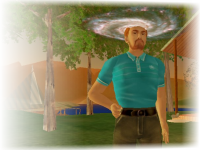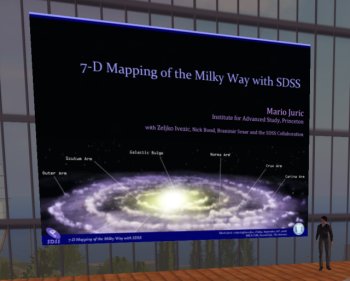Astrophysics in Second Life : 7D mapping of the Galaxy with SDSS
Yesterday (Friday Sep. 26), MICA heard its first Journal Club of the academic year. (We’ve had these before, but it was very slow over the summer.) The talk was Mario Juric from IAS Princeton, talking about mapping density, velocity, and metallicity as a function of spatial position within the Milky Way galaxy, using photometric data from the Sloan Digital Sky Survey.
There were a few conclusions that came out of this. First, unsurprising to anybody who’s read anything about the structure of the Milky Way, the disk and the halo really are completely separate components. The disk appears to have a vertical (i.e. perpendictular to the plan) gradient of metallicity, whereas the halo has a constant (and lower) metallicity distribution. Some density outliers from the smooth background are there, which were known previously, including the Monocerous Tidal Stream discovered by my friend and one-time collaborator Heidi Newberg
However, there were also some surprises. There’s basically no gradient of metallicity radially along the disk. I had previously been under the impression that the disk had a metallicity gradient, with higher metallicities towards the center. One caveat to this: the data does not include the very center of the plane of the disk, so there may well still be a metallicity gradient within the plane.
The biggest surprise to me is that there is no such thing as the “thick disk”. The standard model we’ve had has divided the stellar component of the Milky way into three our for components. There’s the bulge at the center, the very thin halo all around it, and the disk, which was comprised of the thin disk and the thick disk. However, the work we heard about suggests that the disk is a single continuous component with continuously varying properties, not two distinct components.
What’s new about this work? Well, it looks at a much broader range of the sky than any previous survey about the Galaxy. Most previous work has been based on “pencil-beam” surveys that look in a single direction. This survey doesn’t include complete sky coverage, but does include a broad range of coverage that gives us a more complete picture.
Moving on from the science to the culture of it: I quite enjoyed this journal club. Back when I was a grad student at Caltech, it was easy to think that there were too many talks. There were at least four every week that I was “supposed” to go to. Talk fatigue would set in. However, now that I’ve been out of a professional astronomy job for a year, I don’t get these kind of research talks very often any more. I’ve been very grateful for MICA and the opportunity it’s presented for me to keep hearing the occasional research talk about astronomy. If you’re a professional astronomer, consider coming in to Second Life to give us a talk. There are professional astronomers there, travel costs are nil, and we’d love to have you. I personally, and others, will help you figure out how to navigate your way through Second Life if you haven’t been there before. it’s thanks to MICA that I don’t feel completely out of it as an astronomer.
Another interesting thing to note. I’ve found, and have heard others say, that having meetings in Second Life is far less painful than being at a video conference. I hate video conferences, but the sense of “presence” you have with your avatar in Second Life makes meetings there much more bearable. Indeed, they have some huge advantages over real-life meetings, in that in addition to the primary Voice channel, there’s the text chat channel that can be used for aside-conversations, creating what Robert Bloomfield refers to as “constructive cacophany”. I noticed partway through the talk that even though in SL you can pan your camera around to see the slides no matter where you are sitting, we all sat as we would have sat in real life, eschewing the side of the table that would have put our backs to the slides:
There’s a lot of sociological and cognitive psychological work to be done about the nature of human consciousness based on how we behave in virtual worlds… but that’s well outside my area of expertise, so I’ll stop for now.



September 27th, 2008 at 7:24 am
I love the stuff that’s being done with Milky Way structure mapping …. anything that combines Shannon entropy and galaxies has to be awesome, right?
Also, you might want to take the “e” off “Sloane.”
September 27th, 2008 at 8:05 am
I have a mental block against spelling Sloan right, dunno why.